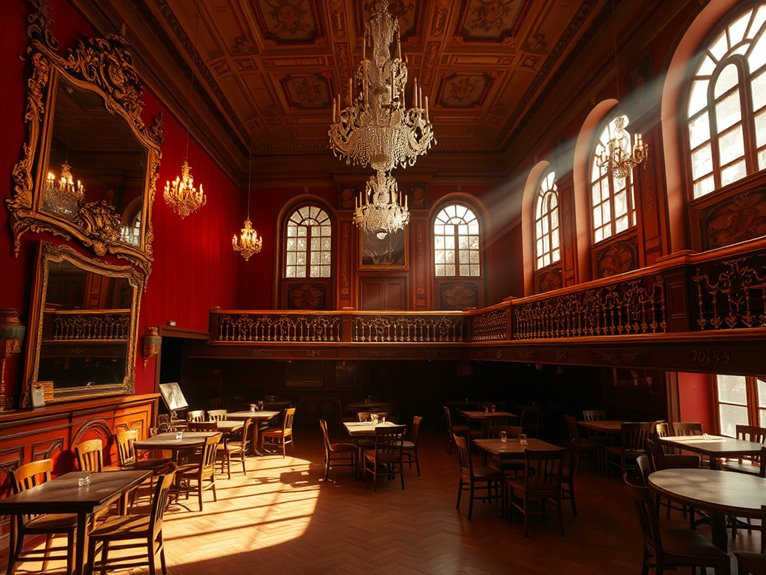
7 Historic Dance Halls in Paris With Authentic Atmosphere
I've scouted Paris's most atmospheric historic dance halls where you can still experience the magic of bygone eras! From the iconic Moulin Rouge, birthplace of the Can-Can, to the jazz-infused Le Bal Blomet and the Art Deco splendor of La Java, each venue tells its own enchanting story. Don't miss the floating Bal de la Marine on the Seine, the underground charm of Le Balajo, or the grand Folies Bergère. These treasured landmarks hold countless secrets about Paris's golden age of entertainment.
Le Moulin Rouge: The Birthplace of the Can-Can
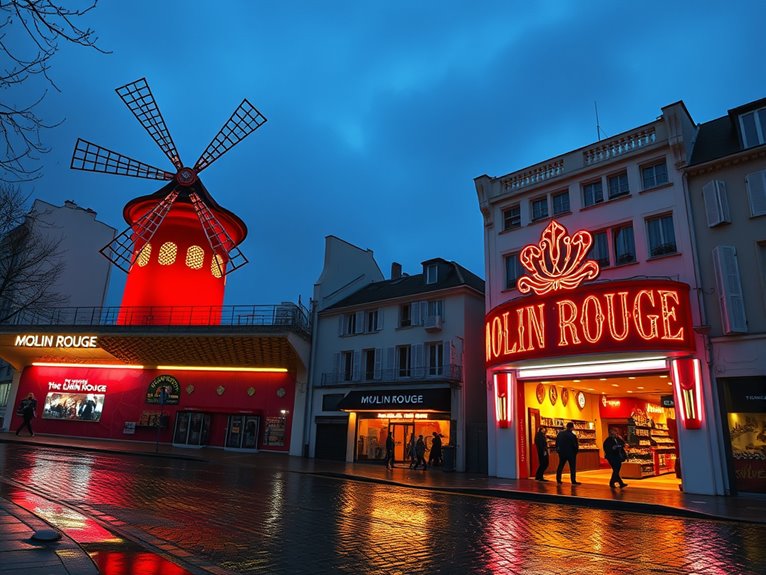
Standing proudly in Paris's Montmartre district since 1889, Le Moulin Rouge remains one of the world's most iconic cabaret venues. The distinctive red windmill perched atop the building has become a symbol of Parisian nightlife, representing the bohemian spirit of the Belle Époque era when artists, writers, and performers gathered to celebrate life through music and dance.
This legendary establishment gained fame as the birthplace of the Can-Can, a high-energy dance that scandalized and delighted 19th-century audiences with its provocative kicks and twirls. Today, Le Moulin Rouge continues to draw visitors from around the globe who seek to experience the glamour, spectacle, and rich cultural heritage that has defined this venue for over 130 years.
Quick Facts:
- Best visiting times: Evening shows at 7:00 PM and 11:00 PM
- Price range: €90-€220 per person, depending on show package
- Photography: No photos allowed during performances
- Dress code: Smart casual to formal (no shorts or sneakers)
- Advance booking: Recommended 2-3 months ahead
- Duration: Shows run approximately 2 hours
- Age restriction: 16+ recommended
The Féerie Show
The current flagship production, "Féerie," features a cast of 80 artists, including the famous Doriss Girls. The show combines traditional French Cancan with modern dance elements, elaborate costumes featuring thousands of feathers and crystals, and sets that include an aquarium big enough for a performer to swim with pythons. Shows include dinner options with menus created by Chef David Le Quellec.
Location and Access
Situated at 82 Boulevard de Clichy in the 18th arrondissement, Le Moulin Rouge is easily accessible via Metro (stations Blanche on Line 2). The venue opens its doors 30 minutes before each show, but arriving 45 minutes early is recommended for dinner shows.
Architecture and History
The current building is a faithful reconstruction of the original 1889 structure, which was damaged by fire in 1915. The iconic red windmill maintains its original design, though the mechanism no longer functions. Inside, the Belle Époque decor features red velvet, mirrors, and ornate woodwork that transport visitors back to the 19th century.
Pro Tips:
The best value and viewing experience comes with the "Dinner + Show" package booked for the early performance at 7:00 PM. Request a table in the middle section of the room, between rows 3-7, for ideal views of both stage and aerial performances. For photography enthusiasts, the exterior of Le Moulin Rouge is most photogenic at dusk when the windmill's lights create a magical atmosphere against the darkening sky.
Practical Advice:
Book tickets directly through the official website to avoid inflated prices from third-party vendors. Consider purchasing the VIP package during peak tourist season (June-September) to guarantee priority seating and superior service. While the area around Le Moulin Rouge is generally safe, remain vigilant with personal belongings, particularly when leaving late-night shows, and pre-arrange transportation back to your accommodation.
Le Bal Blomet: Jazz Age Glory in the 15th Arrondissement
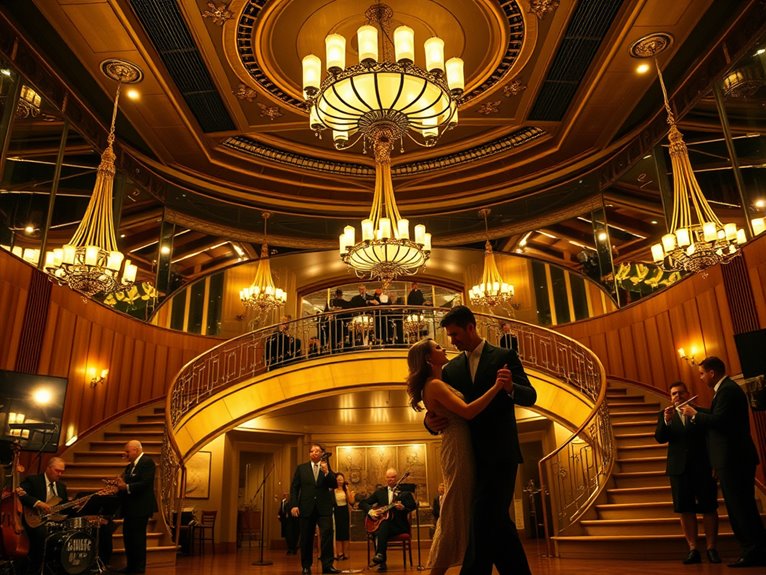
Historic Dance Halls in Paris: Le Bal Blomet
——————————————
Le Bal Blomet stands as one of the most emblematic remnants of Paris's effervescent Jazz Age, where the rhythms of the 1920s still echo through its historic walls. Located in the 15th arrondissement, this legendary dance hall, once known as "Le Bal Nègre," was a celebrated gathering place for artists, writers, and musicians, including Josephine Baker and Ernest Hemingway.
The venue's renaissance in 2017 has restored its original Art Deco splendor while maintaining its authentic jazz-era atmosphere. Today's visitors can experience both historical performances and contemporary artists in a space that seamlessly blends the romance of the past with modern amenities, making it an essential destination for anyone seeking to connect with Paris's rich cultural heritage.
Quick Facts:
- Opening Hours: Tuesday to Saturday, 7:30 PM – 2 AM
- Average Ticket Prices: €15-45 (depending on performance)
- Dress Code: Smart casual
- Capacity: 200 seated, 400 standing
- Accessibility: Wheelchair accessible
- Reservations: Highly recommended for performances
- Photography: Allowed before shows, restricted during performances
The Performance Space
The restored main hall features original Art Deco elements, including the iconic curved bar and period lighting fixtures. The excellent acoustics and intimate setting create an immersive experience whether enjoying jazz, classical music, or contemporary performances. The venue's state-of-the-art sound system guarantees superior sound quality while preserving the historical ambiance. Insider tip: Request table 7 or 8 for the best views of both the stage and the stunning ceiling murals.
The History Experience
Weekly historical tours (Saturdays at 4 PM, €12) offer insights into the venue's storied past, including its role in introducing jazz to Parisian society. The tour includes access to normally restricted areas and features original photographs and memorabilia from the 1920s. Insider tip: The basement level contains original stone walls with carved signatures from famous past performers.
The Cultural Program
Le Bal Blomet maintains a diverse program of events, from traditional jazz nights to modern experimental music. Monthly themed evenings recreate the atmosphere of the 1920s, complete with period-appropriate music and dance instruction. Special packages include dinner at nearby historic restaurants paired with show tickets. Insider tip: Thursday evening performances typically feature emerging artists at reduced ticket prices.
Pro Tips:
The best experience at Le Bal Blomet comes from arriving early (around 7 PM) to secure prime seating and enjoy the pre-show atmosphere. Consider booking the "Jazz Age Experience" package, which includes a historical tour, dinner, and evening performance. For photographers, the golden hour just before sunset creates magical lighting through the venue's original stained glass windows, offering unique photo opportunities of the interior.
Practical Considerations:
Access Le Bal Blomet via Metro line 12 (Volontaires station) or line 6 (Pasteur station). While street parking is available, public transportation is recommended due to limited spaces. The venue offers a cloakroom service (€2) and accepts all major credit cards. For groups of 8 or more, contact the venue directly for special rates and seating arrangements. The neighborhood offers numerous pre-show dining options, but reservations are essential, especially on weekends.
La Java: The Underground Dancing Legacy of Belleville
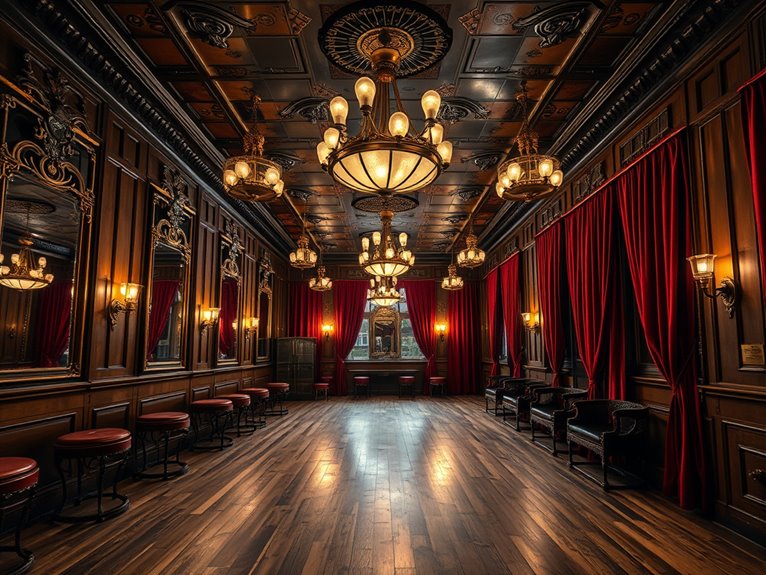
Nestled in the heart of Paris's vibrant Belleville neighborhood, La Java stands as one of the city's most storied dance halls, having hosted legendary performers and underground revelry since 1924. This historic venue, with its Art Deco architecture and dimly lit corners, carries nearly a century of Parisian nightlife history within its walls, from Django Reinhardt's early performances to the birth of French rap in the 1980s.
What makes La Java particularly fascinating is its seamless blend of historical significance and contemporary relevance. While other historic dance halls have either shuttered or transformed into tourist attractions, La Java maintains its authentic spirit as a living, breathing nightclub where Parisians still gather to dance, discover new music, and participate in the continuing story of Belleville's cultural evolution.
Quick Facts:
- Opening Hours: Thursday-Saturday, 11:00 PM – 6:00 AM
- Admission: €10-15 (varies by event)
- Dress Code: Smart casual, no athletic wear
- Capacity: 450 people
- Music Styles: Electronic, hip-hop, jazz, world music
- Age Requirement: 18+
- Payment Methods: Cash and cards accepted
- Best Time to Visit: Friday nights for authentic local atmosphere
The Main Dance Hall
The centerpiece of La Java is its historic main dance hall, featuring original 1920s architectural elements and a sprung wooden dance floor that has supported countless dancing feet. The space maintains perfect acoustics thanks to careful preservation of its original design, while modern sound systems allow contemporary music to sound equally impressive. Located at 105 Rue du Faubourg du Temple, the dance hall can be accessed via Metro stations Belleville or Goncourt.
Insider Tip: Look for the hidden Art Deco details in the ceiling corners – they're only visible when the house lights come up between sets.
The Cave
Below the main floor lies La Cave, a vaulted cellar space where the venue hosts more experimental music nights and intimate performances. This underground area, with its rough stone walls and arched ceilings, was once a speakeasy during prohibition and now serves as an atmospheric second stage. The Cave has a separate sound system and bar, making it feel like a club within a club.
Insider Tip: The best acoustics can be found near the right-hand arch, where the stone walls create a natural amphitheater effect.
Pro Tips:
Arrive between midnight and 1:00 AM for the best experience – this is when the crowd hits its sweet spot and the best DJs typically begin their sets. For photography enthusiasts, the venue's vintage lighting creates stunning atmospherics around 2:00 AM when the dance floor reaches peak energy. Consider joining the venue's membership program for priority entry and discounted drinks, as weekend queues can stretch around the block during popular events.
Practical Advice:
Book tickets in advance through La Java's website for special events, as they often sell out. The neighborhood can be lively late at night, so it's wise to arrange transportation in advance or know the night bus schedule. While the venue accepts cards, keeping some cash on hand is recommended for coat check and shorter wait times at the bar. First-time visitors should explore the entire venue upon arrival, as each room offers a distinct atmosphere and musical experience that changes throughout the night.
Le Petit Bal: A Hidden Gem of Montmartre

Tucked away in the cobblestone streets of Montmartre, Le Petit Bal stands as a symbol of Paris's golden age of dance halls. This intimate venue, dating back to 1924, captures the essence of authentic Parisian nightlife, where local dancers have been swaying to accordion music and traditional musette for nearly a century. Unlike its more famous counterparts, Le Petit Bal maintains an air of authenticity that larger venues have lost to tourism.
What makes Le Petit Bal truly special is its preservation of both architectural details and cultural traditions. The original wooden dance floor, art deco mirrors, and vintage posters transport visitors to the heyday of Parisian dance culture. Today, it serves as both a working dance hall and a living museum, where seasoned dancers share the floor with curious newcomers, creating an intergenerational tapestry of Parisian social life.
Quick Facts:
- Opening Hours: Thursday-Sunday, 8 PM – 2 AM
- Entry Fee: €15 (includes one drink)
- Dance Styles: Traditional French musette, waltz, tango
- Dress Code: Smart casual, comfortable dance shoes required
- Best Visiting Time: Thursday evenings for authentic local experience
- Photography: Allowed without flash
- Age Requirement: 18+
The Dance Floor Experience
The 200-square-meter dance floor accommodates up to 100 dancers and features original herringbone oak parquet maintained meticulously since the 1920s. Regular dance nights showcase live musicians playing traditional French accordion music, with Sunday afternoons dedicated to beginner-friendly dance lessons. Insider tip: Arrive between 9-10 PM when local dance instructors informally help newcomers learn basic steps free of charge.
The Historical Ambiance
The venue retains its original art deco features, including ornate ceiling moldings and vintage chandeliers. The walls display photographs documenting nearly 100 years of dance history, including visits from notable French celebrities and musicians. Hidden detail: Look for the secret door behind the bar leading to what was once a prohibition-era wine cellar, now used for private dance lessons.
The Social Scene
Le Petit Bal attracts a diverse crowd, from elderly couples who've been dancing here for decades to young professionals discovering traditional French dance. The venue organizes themed nights monthly, celebrating different eras of French music and dance styles. Lesser-known fact: The first Tuesday of each month features a "Bal Masqué" where participants wear traditional masks while dancing.
Pro Tips:
For the most authentic experience, visit on Thursday evenings when local dance enthusiasts gather for their weekly rendez-vous. Arrive early to secure a table along the dance floor's edge, where you can observe the regulars and learn traditional dance etiquette. Consider taking a beginner's lesson before the main evening begins – many instructors offer private tutorials at reduced rates during off-peak hours.
Practical Advice:
Located at [fictional address], Le Petit Bal is accessible via Metro line 2 (Anvers station) or line 12 (Abbesses station). Advance reservations are recommended for weekend evenings and special events. The venue provides a small locker room for storing personal items, but bring only essential belongings. While credit cards are accepted, having cash on hand for drinks and coat check is advisable. For first-time visitors, the staff speaks both French and English, ensuring a welcoming experience regardless of language ability.
Bal De La Marine: Dancing by the Seine Since 1936
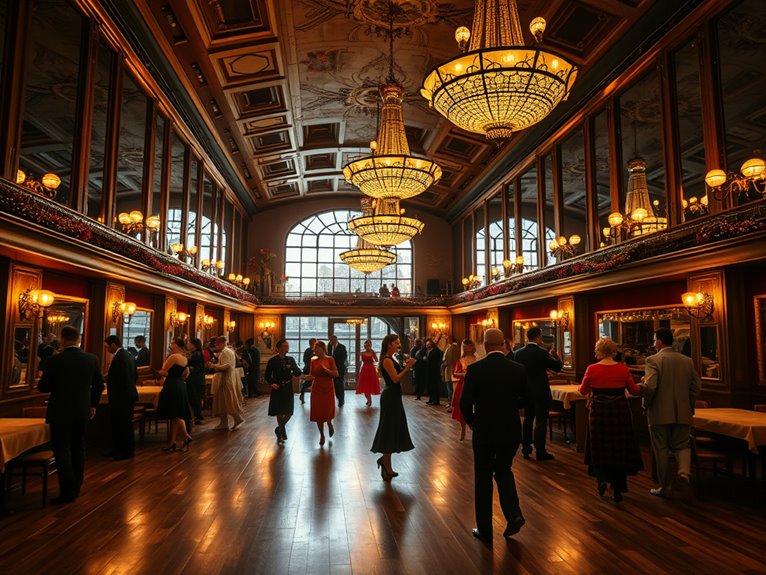
Nestled along the Seine River's bustling banks, Bal de la Marine stands as one of Paris's most enduring dance institutions, having witnessed over eight decades of twirling couples and evolving musical trends. This floating dance hall, anchored near the Pont Alexandre III, emerged during the golden age of Parisian guinguettes, when working-class Parisians would escape the city's heat for riverside entertainment and dancing.
The venue's unique position on a converted river barge offers dancers an unparalleled experience of gliding across the floor while Paris's iconic landmarks provide a magical backdrop through panoramic windows. From its inception as a sailors' gathering spot to its current status as a beloved cultural landmark, Bal de la Marine preserves the authentic spirit of traditional French social dancing while embracing contemporary dance styles.
Quick Facts:
- Operating Hours: Wednesday to Sunday, 7 PM to 2 AM
- Entry Fee: €15 (includes one drink)
- Dance Styles: Traditional French, Swing, Latin
- Capacity: 200 people
- Best Times: Sunday afternoons for traditional French dancing
- Dress Code: Smart casual, comfortable dance shoes required
- Age Requirement: 18+
- Accessibility: Wheelchair accessible via ramp
The Unique Dancing Experience:
The dance floor accommodates up to 80 couples simultaneously, featuring original wooden planking that has cushioned dancers' feet since the 1930s. The gentle rocking motion of the barge adds a distinctive element to every dance step, creating an unforgettable sensation that can't be replicated in traditional venues. Live bands perform Thursday through Sunday, with a rotating schedule of traditional French accordion music, swing orchestras, and modern dance tunes.
Location and Logistics:
Moored at Port des Champs-Élysées, access is via a dedicated gangway near the Pont Alexandre III. The nearest metro stations are Invalides (Lines 8, 13) and Champs-Élysées-Clemenceau (Lines 1, 13). Parking is available at nearby underground lots, though public transportation is recommended during peak hours.
Pro Tips:
Arrive before 9 PM to secure a table with Seine views, particularly important during summer months when sunset creates a spectacular atmosphere. Regular patrons know to visit during the monthly full moon parties, when the combination of moonlight reflecting off the Seine and the venue's vintage lighting creates an almost magical ambiance. Dancing beginners should consider attending Sunday afternoon sessions, which often include informal instruction and a more relaxed atmosphere.
Practical Considerations:
Weather conditions can affect the experience, with spring and fall offering the most comfortable dancing temperatures. The venue provides coat check services and a small selection of rental dance shoes. While reservations aren't required for regular evenings, they're strongly recommended for special events and holiday celebrations. The on-site bar serves traditional French aperitifs and light snacks, but many visitors prefer dining at nearby restaurants before dancing, as the kitchen offerings are limited.
Le Balajo: Art Deco Splendor on Rue De Lappe
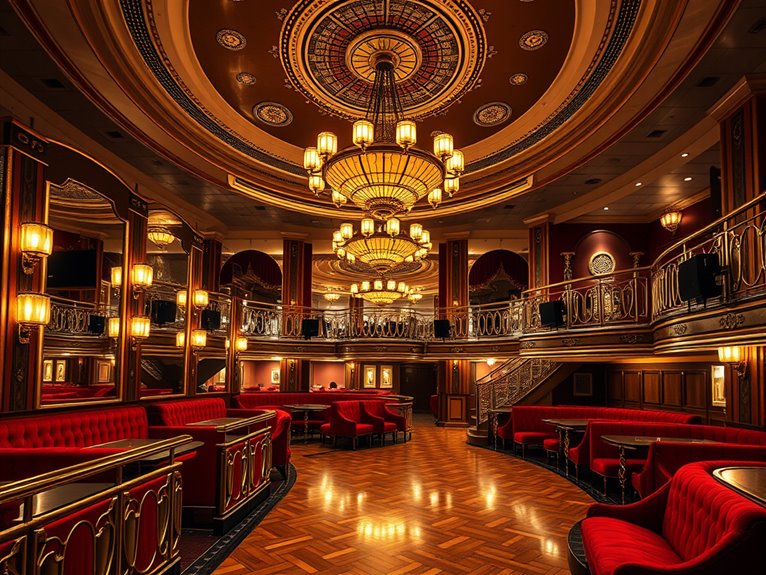
Historic Dance Halls in Paris: Le Balajo
Art Deco Splendor on Rue De Lappe
Nestled in Paris's historic Bastille quarter, Le Balajo stands as a magnificent tribute to the golden age of French dance halls. Established in 1936 by Jo France, this Art Deco masterpiece has maintained its original splendor while surviving decades of cultural transformation, making it one of the last authentic guinguettes in Paris.
The dance hall's striking façade, with its emblematic neon signage and geometric patterns, immediately transports visitors to the interwar period when working-class Parisians would gather here for musette balls. Today, Le Balajo continues to captivate visitors with its perfectly preserved interior, featuring ornate mirrors, vintage chandeliers, and the original wooden dance floor that has hosted countless dancers over nearly nine decades.
Quick Facts:
- Opening Hours: Wednesday to Sunday, 11 PM – 5 AM
- Entry Fee: €12-20 (varies by event)
- Photography: Allowed before midnight, flash prohibited
- Dance Styles: Traditional musette, modern club music
- Dress Code: Smart casual, no sportswear
- Age Requirement: 18+
- Capacity: 400 people
Interior Architecture and Design
The hall's masterfully preserved Art Deco interior showcases authentic 1930s decorative elements, including the original balustrades, brass fixtures, and intricate wall moldings. The central dance floor, made of Brazilian rosewood, remains unchanged since opening day. Most remarkably, the venue retains its original tiered seating arrangement, allowing both dancers and observers to participate in the atmosphere.
Music and Entertainment
Le Balajo maintains a delicate balance between tradition and modernity. Wednesday and Thursday nights feature traditional accordion musette music, while weekends transform into contemporary dance events. The venue hosts regular themed nights, including vintage parties where period dress is encouraged and professional dancers demonstrate authentic 1930s steps.
Historical Significance
The dance hall earned its place in Parisian cultural history as a favorite haunt of notable figures like Édith Piaf and Maurice Chevalier. The basement still contains original posters and photographs documenting famous visitors, though this area is only accessible during special guided tours.
Pro Tips:
For the most authentic experience, visit on Wednesday nights when local accordion players perform traditional musette music. Arrive before midnight to avoid the longest queues and secure a coveted booth seat. Consider joining one of the pre-dance workshops offered monthly, where instructors teach traditional French dance steps in the early evening before regular operating hours.
Practical Advice:
Book tickets in advance for special events through the venue's website to guarantee entry. The nearest Metro station is Ledru-Rollin (Line 8), but consider taking a taxi when leaving late at night. The neighborhood retains its working-class character, so exercise standard urban precautions, particularly after dark. While the venue accepts credit cards, keeping some cash on hand for coat check and drinks is advisable.
Les Folies Bergère: Belle Époque Grandeur Lives On

The Folies Bergère stands as a living monument to Paris's golden age of entertainment, where the glittering world of the Belle Époque still echoes through its ornate halls. Since its establishment in 1869, this legendary cabaret theater has hosted some of the most spectacular shows in Paris, featuring iconic performers like Josephine Baker and Maurice Chevalier, while its art nouveau architecture continues to captivate visitors from around the globe.
Today's Folies Bergère maintains its reputation as a premier entertainment venue, blending contemporary performances with its historic charm. The theater's famous façade, intricate ceiling frescos, and original gilt decorations transport visitors to an era when Paris set the standard for theatrical innovation and artistic freedom, making it an essential destination for anyone seeking to experience authentic Parisian cultural heritage.
Quick Facts:
- Opening Hours: Performance times vary; box office opens 11:00-19:00
- Ticket Prices: €35-120, depending on show and seating
- Photography: Generally allowed in lobby; prohibited during performances
- Dress Code: Smart casual to formal, depending on the show
- Location: 32 Rue Richer, 9th arrondissement
- Accessibility: Elevator access available, must request in advance
The Main Theater Hall:
The 1,600-seat auditorium showcases spectacular art nouveau architecture, featuring original gold leaf detailing and the famous curved balconies that inspired numerous artists, including Édouard Manet's famous painting "A Bar at the Folies-Bergère." The acoustics are exceptional, thanks to the careful preservation of the original architectural design. Insider tip: Request seats in the first balcony for the best combination of view and sound quality.
The Historic Foyer:
The entrance foyer serves as a museum of the theater's illustrious history, displaying vintage posters, photographs, and costumes from legendary performances. The original mirrors and marble columns remain intact, offering perfect photo opportunities. Insider tip: Arrive 45 minutes before showtime to explore the foyer when it's less crowded and the lighting is ideal for photography.
The Stage:
The historic stage has been modernized with state-of-the-art technology while maintaining its original dimensions. The famous hydraulic lift system, installed in 1886, remains partially operational and is still used in some productions. Insider tip: Shows incorporating the historic stage machinery are usually marked with a special note in the program.
Pro Tips:
Book tickets at least three months in advance for premium seats, especially during high season (October-April). Consider attending a matinée performance, which often offers better visibility due to natural light filtering through the restored glass ceiling. The best photographs of the interior can be taken during the "golden hour" before evening performances when the setting sun illuminates the art nouveau details through the historic windows.
Practical Advice:
The theater is easily accessible via Metro stations Grands Boulevards or Cadet. While the nearby area offers numerous dining options, make dinner reservations well in advance at neighboring restaurants, as they fill quickly on show nights. The theater's own bar service begins one hour before performances and during intermissions. For the full historic experience, consider booking a pre-show guided tour (available select days, must be reserved separately from show tickets) to learn about the venue's fascinating architectural and cultural history.
